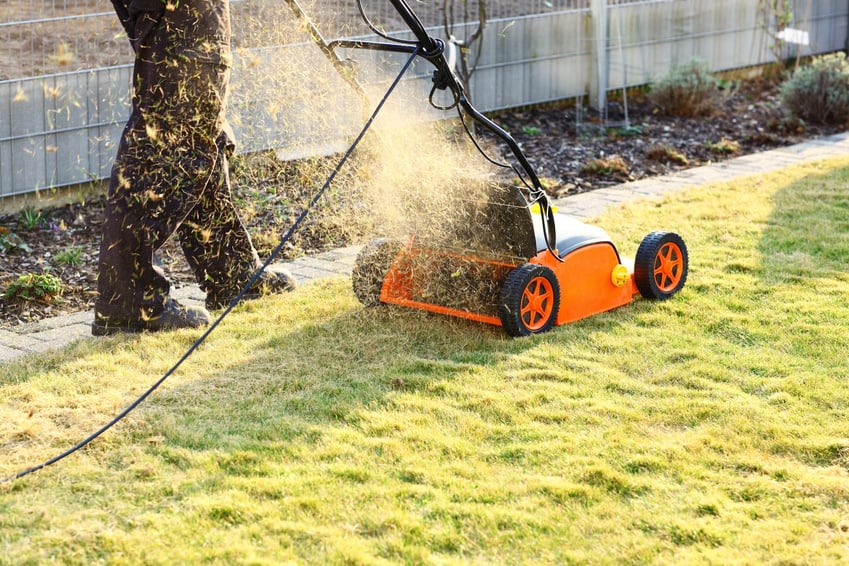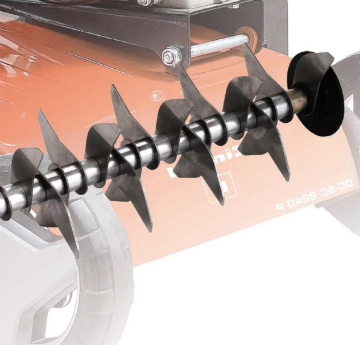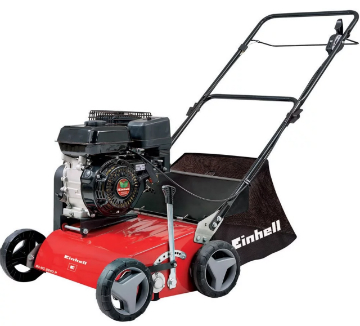Do I Need a Scarifier?

A scarifier in action
Most lawns, at some time or another, will benefit from scarifying. This process can help your lawn breathe and leave it looking greener and more healthy.
Perhaps your lawn is feeling rather springy or spongy? Perhaps there are yellow patches, perhaps the lawn is not draining well and puddles form? If so it is probably a build up of thatch.
All lawns at some stage will be prone to this and some raking or scarifying at the right time, and with the right equipment can be very beneficial to your lawn’s health.
What Exactly Is Thatch?
Thatch is organic material that has built up amongst the grass plants of your lawn. A lawn, of course, is made up of individual plants, about 850 per square foot (approximately 0.093 sq metres ).
Basic thatch is actually the result of normal lawn growth. Grass contains a substance called ‘lignin’ which means that plants die and fall, as part of their life cycle, but they don’t rot. They stay inside the lawn and build up as new young plants grow.
Water, air and sunlight provide the nourishment and conditions the lawn needs to grow and be healthy, the thatch can start to choke the new growth and prevent the air, water and sunshine from getting through.
When thatch reaches a thickness of more that around half a centimetre to 1 centimetre 30, it really starts to become a hazard for the new growth, in effect choking the lawn and preventing it from flourishing.
Tip: Get down and look closely, if you can see a lot of dead, yellow material in there, that is thatch.
Is Thatch The Only Problem?
No. Other organic material, dead weeds, moss and so on can also build up in your lawn, also making it difficult for the turf to thrive. Also, soil compaction can also prevent the lawn growing and thriving. Scarifying can help with this too.
Why Don’t I Just Use an Aerator?
An aerator, while it does a very useful and, some would say vital, job, will not remove anywhere near as much organic material. Aerators concentrate on creating holes for letting air and water in, helping stop the effects of compaction and some of the symptoms of thatch, whereas a scarifier carries out both these tasks and removes a lot of material, stopping the thatch blocking growth.
So What Exactly Is Scarifying?
Scarifying could be described as deep raking. Running a rake across your lawn will remove some organic detritus but scarifying will remove a lot more. As one of our customers points out…
“The amount of moss and thatch ripped up on the first two passes on the highest setting was incredible…manual raking was getting nowhere” ANDREW
Scarifying involves penetrating the lawn with blades that cut into the turf and remove large amounts of organic material. In the process they leave holes in the ground that enable more air and water to get into the grass and the soil.
How Do I Scarify?
Well, as mentioned before, you can carry out a basic process with a sprung lawn rake. However, this is not really scarifying, won’t remove much thatch at all and will be limited in its success. So for the best results a mechanical scarifier of some sort is definitely a good option.
How Does a Scarifier Work?
Steel blades are set into a roller in a wheeled machine so that as you propel the scarifier forward penetration occurs at regular intervals. The blades revolve forwards and clockwise so the organic material is left behind.

Scarifier – How It Works
There will usually be choice of height settings so can regulate how deep you need your scarifying to be and better versions will have wide-tread wheels to make sure you do no damage to the turf as you work.
What Sort of Scarifiers Are Available?
There are many types available, from towed models to mains electric and petrol versions and nowadays a growing number of powerful battery powered scarifiers. Some are hand-propelled and some are propelled to make the work easier and faster.
The popular Einhell GC-SC 2240P Petrol Lawn Scarifier
You will also find combi scarifiers that include both an aerating and a scarifying device, offering 2-in-1 lawn care. At certain times of year you will not need to scarify and can simply aerate.
Will I See Results Quickly?
No. Probably not. In fact you may feel as though you have done something foolish when you have finished. This is normal. The process of scarifying can leave your lawn, initially, looking pretty ragged.
“The result obviously looks fairly devastating while we wait for the grass to start growing but many barrow-loads of moss and thatch were effectively removed so I am very pleased” ROGER
This is, of course, dependant on how much of your lawn is taken over by thatch or moss. Most people who buy a scarifier for the first time are a little bit shocked, but remember, this is freeing up the lawn to grow again and to be free of the clogging effects of moss and thatch.
Do I Need To Do Any Preparation Before Scarifying?
Yes. The grass should be short so if your lawn has long grass start cutting it down in stages a couple of weeks before you start.
If you have obvious weeds try to get rid of them first and make sure there are no obstacles, large stones etc in the grass as you would do if you were mowing.
Check the lawn’s moisture content before you start. Don’t scarify if it is dewy, it is probably better to wait until later in the day.
When Should I Scarifiy?
It really depends. Light scarifying, not going too deep, is beneficial, generally in late spring from somewhere around the middle of April to June and in late summer early autumn, around late August to September.
Heavier, more aggressive scarifying is possible in the Autumn (again think Late August early September, maybe even early October depending on weather conditions).
Bearing in mind the earlier mention of how your lawn might look after you have finished scarifying, this is a is good time, as you are less likely, having taken your lawn apart, to have problems with weeds seeding and filling in the spaces you have left in the lawn.
However, if you have a lot of shade in your garden, trees, large bushes etc, you might find autumn is not so good as the grass will be a little thin at that time.
Should I Scarify In Winter?
In nearly all cases, NO. It is all to do with the weather and the moisture that is around. The best conditions in which to scarifiy is when there is some moisture on the ground but it is not wet and not too dry.
Trying to scarify a lawn that is wet can leave a real mess and cause damage to the lawn, and trying to dig into a lawn when it is cold and frosted and the ground hard can also do serious damage. It is generally best avoid trying to scarify in January and February altogether.
What Should I Do With The Detritus I Remove?
Most scarifiers come with collection boxes or bags like a lawn mower. However, in my experience scarifiers seem to take out much more material than most grass collection boxes can handle.
Most first time scarifier owners are seriously amazed, even shocked, by how much they can remove.
“I could not believe the amount of moss that it cleared” ARNOLD
If there is too much for your collection bag and you don’t want to keep emptying, remove the bag and let the material fall to the lawn. Then just rake it up and put it on the compost heap. DON’T leave it on the lawn.
And don’t forget, MowDirect carries a great range of scarifiers of all kinds. You can see the whole range here.
And if you need more advice and guidance, just call our product advisors on 0345 4588 905 (9am-5pm Mon-Fri & 10am-4pm Sat) We are proud of our product knowledge.
“Excellent Product and Outstanding Service. The advice I received from MowDirect was spot on and this product was perfect” PAUL
